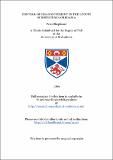Files in this item
Control of head movement in the locust schistocerca gregaria
Item metadata
| dc.contributor.advisor | Horridge, G. Adrian | |
| dc.contributor.author | Shepheard, Peter | |
| dc.coverage.spatial | xii, 255 p. | en_US |
| dc.date.accessioned | 2018-07-04T12:52:20Z | |
| dc.date.available | 2018-07-04T12:52:20Z | |
| dc.date.issued | 1969 | |
| dc.identifier.uri | https://hdl.handle.net/10023/14917 | |
| dc.description.abstract | 1. Head movement in the locust Schistocerca gregaria is mediated by 14 pairs of muscles. The normal motor output to, and the innervation pattern and muscle fibre spectrum of many of these muscles have been examined by a variety of histological and experimental techniques. 2. The anatomy, histology and the fine structure of the neck muscalature and innervation have been examined by both light and electron microscopy. The axons to some muscles have been traced by serial sections from the ganglion of origin to the muscle concerned, and axon counts of each motor nerve have been made. 3. The inervation pattern of many muscles has been investigated by recording with two intracellular microelectrodes from different fibres of the same or different muscles during graded stimulation of the motor nerve or nerves. 4. Both the normal motor output to, and the innervation pattern and muscle fibre spectrum of, many muscles have been investigated in the intact insect by recording with two intracellular microelectrodes from different fibres of a muscle during optokinetic nystagmus elicited by rotation of a striped drum in the visual field. Each electrode is inserted through a small hole in the exoskeleton into a fibre of the muscle close to its fixed insertions on the prothorax. 5. The sensory innervation of the neck and prothoras has been examined, and some of the sense organs are described. A chordotonal organ is attached to each lateral longitudinal muscle of the neck, and the system is so arranged as to be ideally situated for monitoring lateral head movement. The sense organ is shown to serve such a proprioceptive function. Chordotonal organs attached to muscles have not been previously described in insects. 6. A number of structural differences are found between muscle fibres, and each muscle contains a variety of muscle fibre types classified on the basis of electrical responsiveness to innervation. In one muscle, a definite correlation is shown between the structural and physiological differences between different muscle fibres. In this muscle, the larger fibres are of phasic type and have shorter sarcomeres and smaller fibres are of tonic type and have longer sarcomeres. In general, however, the structural differences between fibres in different muscles are greater than the differences between fibres in the same muscle. | en_US |
| dc.language.iso | en | en_US |
| dc.publisher | University of St Andrews | |
| dc.subject.lcc | QL509.S5 | en |
| dc.subject.lcsh | Locusts—Anatomy | en |
| dc.title | Control of head movement in the locust schistocerca gregaria | en_US |
| dc.type | Thesis | en_US |
| dc.contributor.sponsor | Medical Research Council (MRC) | en_US |
| dc.type.qualificationlevel | Doctoral | en_US |
| dc.type.qualificationname | PhD Doctor of Philosophy | en_US |
| dc.publisher.institution | The University of St Andrews | en_US |
This item appears in the following Collection(s)
Items in the St Andrews Research Repository are protected by copyright, with all rights reserved, unless otherwise indicated.

